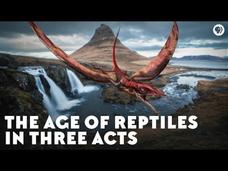SciShow
7 Animals with Super Weird (and Sometimes Horrifying) Teeth
Humans don't have interconnected teeth for slicing, or a secondary set of jaws to clamp down on prey already in our mouths, however, the rest of our animal kingdom is full of strange and awesome adaptations. Hosted by: Olivia Gordon...
National Geographic
This Fish "Walks" Like Our Prehistoric Ancestors | National Geographic
This animal, called a “little skate,” may be providing us clues to the evolutionary development of land-dwelling locomotive behavior. ➡ Subscribe: http://bit.ly/NatGeoSubscribe About National Geographic: National Geographic is the...
Curated Video
Fossil Fuels: Formation
Where does our natural gas, coal and oil actually come from? Discover the processes that created our modern fossil-fuel reserves, which began millions of years ago. Earth Science - Earth's Resources - Learning Points. Fossil fuels are...
Curated Video
SPANISH-Simm Taback's Dinosaurs: Los dinosaurios de Simms Taback
Uno de estos dinosaurios tiene patas traseras más cortas que las delanteras. Otro tiene tres cuernos—dos grandes y uno pequeño—con una cabeza gigante y un volante en el cuello. Otro no tiene dientes pero tiene un pico largo y puntiagudo...
National Geographic Kids
T. Rex | DINO ROAD TRIP
Ali and Sean travel back 66 million years to get a look at the most famous dinosaur of all time—the Tyrannosaurus Rex! Tour guide Simon reveals that the T. rex may be related to … a chicken? Find out if Simon is for real—or for the...
National Geographic Kids
Spinosaurus | DINO ROAD TRIP
Spinosaurus may have been the biggest meat-eating dinosaur that ever lived—and Ali and Sean travel back 100 million years to North Africa to check it out. Tour guide Simon explains how Spiney lived in and out of the water and hunted for...
Gresham College
Humanity and a Million Years of Sea Level Change - Dr Nicholas Flemming
Homo sapiens evolved over the last million years during which time the climate fluctuated strongly. Ice accumulated and melted again, exposing and flooding the continental shelves - land which was colonised by plants and animals. About...
The Wall Street Journal
Sustainability in Private Markets
Private equity backed companies form a large part of the economy. The Carlyle Group's Global Head of Impact Megan Starr discusses how these businesses are progressing on sustainability.
Curated OER
Sea Monsters 3
"Sea Monsters 3," the final video of a three-part series, takes a close look at the styxosaurus. It resembles a long-neck dinosaur under the sea. This video will also discuss the dolichorhynchops and the herperornis.
PBS
The Age of Reptiles in Three Acts
Reptiles survived the largest extinction event on the planet and then they grew into the most dominant class of the Mesozoic Era. They quickly evolved into giants on land, sea, and air. In an episode of the PBS Eons series viewers learn...
Curated OER
Sharks vs. Dinosaurs
A young reptile must use its natural speed to steer free from the shark. Watch this video to learn how another prehistoric animal keeps himself under the sea.
PBS
When Whales Walked
Remember that time whales were the size of house cats and walked on land? It's true—the evolution of whales is stranger than many suspect! See it all unfold in a historical video from PBS Eons channel that presents the evidence proving...
PBS
Pbs Learning Media: Dinosaur Train: The Kids Learn About Archelons
In this Dinosaur Train clip Gilbert teaches the kids about the giant prehistoric sea turtle called Archelon. Gilbert reminds the kids that different species behave differently and have unique life cycles. Take this video as an...










